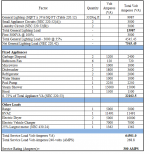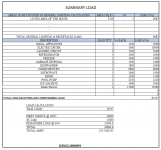VENgineer
Member
- Location
- Miramar Fl
- Occupation
- Electrical Engineer
I have a question. I'm calculating the electrical load for a house of approximately 3,500 sq. ft. To summarize the major loads, there are 2 dryers, 1 range+oven, 1 steam shower (15,000 kW), 12,000 kW in AC equipment (2 units in total), a pool water pump, and an electric car charger, 1 outdoor kitchen on the pool area with diswasher and g.disposal. The water heater is gas-powered.
Using the Standard method, I get a total load of 64,500 VA - 267 Amps, while with the Optional method, I get a result of 43,000 VA - 179 Amps.
My question is, due to the significant difference between both results, which method should I lean towards when calculating the service?
I'm more inclined towards the Standard method in this case because the main difference lies in the shower steamer that the customer wants to install. However, I'm unsure how common a 300A service is for a residence.
What do you advise in this case?
Thank you in advance.
Using the Standard method, I get a total load of 64,500 VA - 267 Amps, while with the Optional method, I get a result of 43,000 VA - 179 Amps.
My question is, due to the significant difference between both results, which method should I lean towards when calculating the service?
I'm more inclined towards the Standard method in this case because the main difference lies in the shower steamer that the customer wants to install. However, I'm unsure how common a 300A service is for a residence.
What do you advise in this case?
Thank you in advance.



